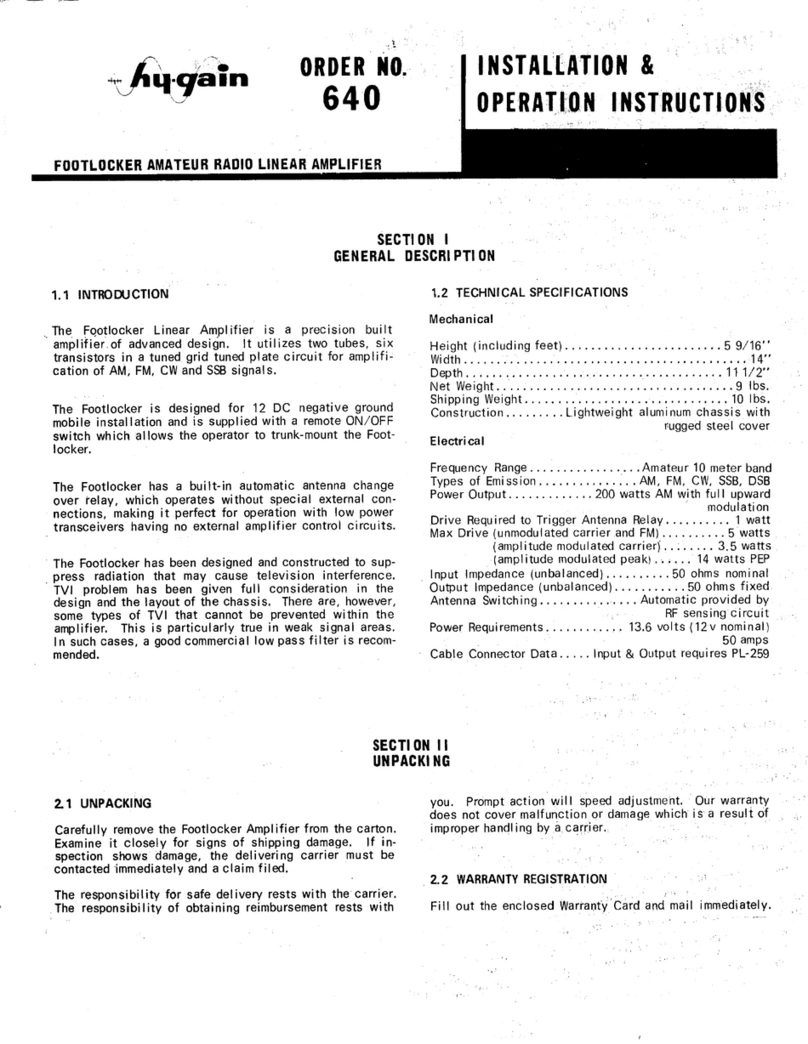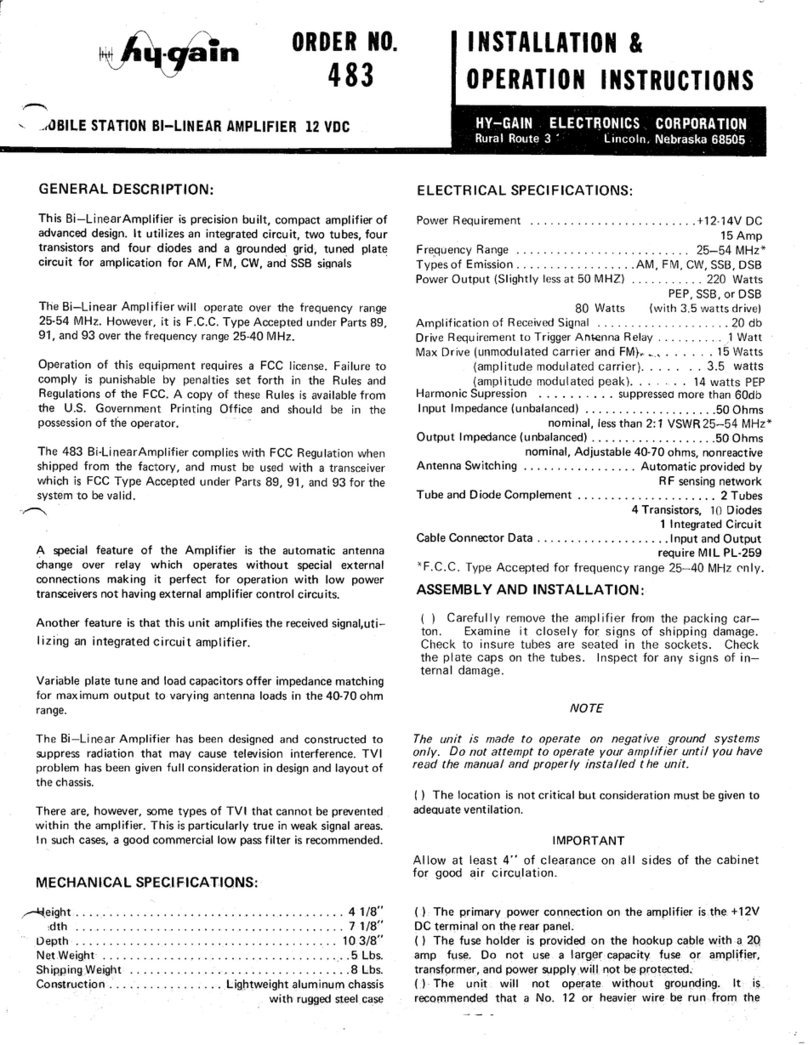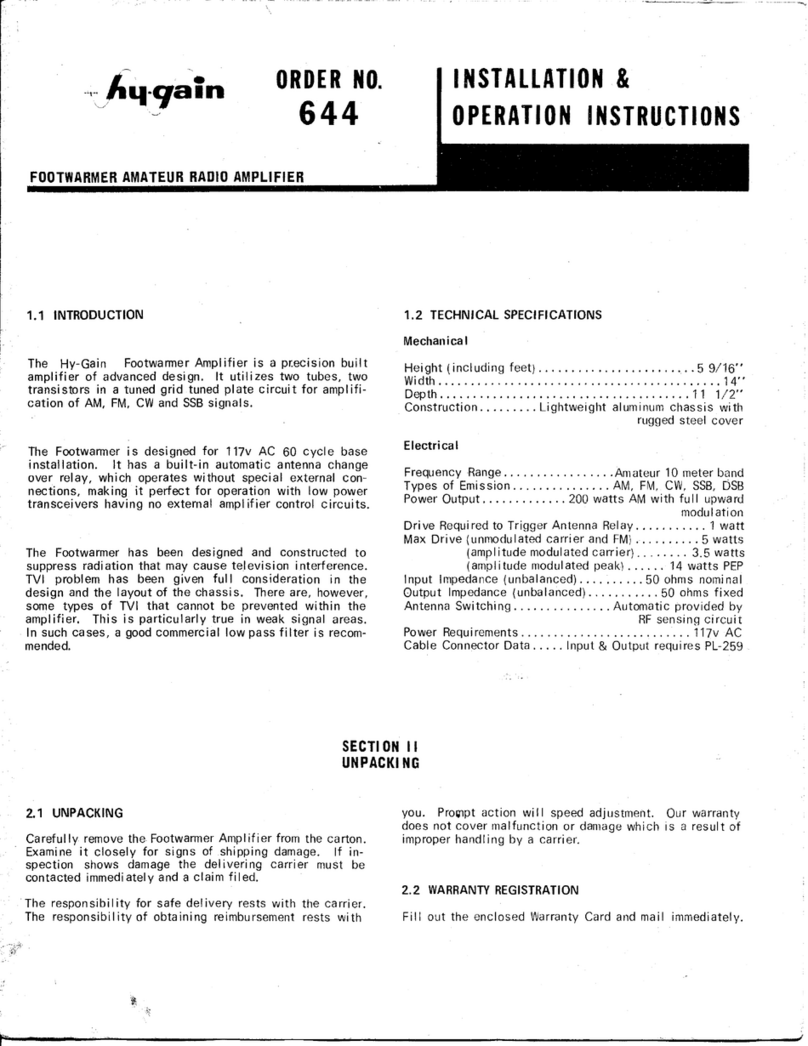. AFTERBURNER
ORDER NO.
419
MOBILE STATION 12V DC
BI LATERAL LINEAR AMPLIFIER
INST ll TION
OPER TION INSTRUCTIONS
AFTERBURNER
RuraI Route 3
Lincoln. Nebraska 68505
This Bi-Lateral Amplifier is precision built, compact amplifier of
advanced design. It utilizes an integrated circuit, two tubes, four
transistors and four diodes and a grounded grid, tuned plate
circuit for amplication for AM, FM, CW, and SSB signals in the
25-54 MHz range.
A special feature of the Amplifier is the automatic antenna
change over relay which operates without special external
connections making it perfect for operation with low power
transceivers not having external amplifier control circuits.
Another feature is that this unit amplifies the received signal,uti-
lizing an integrated circuit amplifier.
Variable plate tune and load capacitors offer impedance matching
for maximum output to varying antenna loads in the 40-70 ohm
range.
~The Bi-Lateral Amplifier has been designed and constructed to
suppress radiation that may cause television interference. TVI
problem has been given full consideration in design and layout of
the chassis.
There are, however, some types of TVI that cannot be prevented
within the amplifier. This is particularly true in weak signal areas.
In such cases, a good commercial low pass filter is recommended.
Height 4 1/8
Width 7 1/8
Depth 103/8
Net Weight 5 Lbs.
Shipping Weight 8 Lbs.
Construction Lightweight aluminum chassis
with rugged steel case
Power Requirement +12-14V DC
15 Amp
Frequency Range 25-54 MHz
Types of Emission AM, FM, CW, SSB,DSB
Power Output (Slightly less at 50 MHZ) 220 Watts
PEP, SSB, or DSB
.~ 100 Watts (with 3.5 watts drive)
Amplification of Received Signal 20 db
Drive Requirement to Trigger Antenna Relay 1 Watt
Max Drive (unmodulated carrier) 15 Watts
Odd Order Distortion Products 30 db below peak output
Harmonic Suppression 2nd Harmonic at least
35 db below peak output
Input Impedance (unbalanced) 50 Ohms
nominal, less than 2: 1 VSWR 25-54 MHz
Output Impedance (unbalanced) 50 Ohms
nominal, Adjustable 40-70 ohms, nonreactive
Antenna Switching Automatic provided by
RF sensing network
Tube and Diode Complement 2 Tubes
4 Transistors, 4 Diodes
1 Integrated Circuit
Cable Connector Data Input and Output
require MIL PL-259
() Carefully remove the amplifier from the packing carton.
EX::lmineit closely for signs of shipping damage. Remove the four
screws holding the top cabinet and remove all hold-down tape
and packing materials. Check to insure tubes are seated in the
sockets. Install the plate caps on the tubes and the fuse in the
holder. Inspect for any signs of internal damage.
The unit is made to operate on negative ground systems
only. Do not attempt to operate your amplifier until you have
read the manual and properly installed t he unit.
() The location is' not critical but consideration must be given to
adequate ventilation.
IMPORTANT
Allow at least 4 of clearance on all sides of the cabinet
for good air circulation.
() The primary power connection on the amplifier is the +12V
DC terminal on the rear panel.
() The fuse holder is provided on the hookup cable with a 20
amp fuse. Do not use a larger capacity fuse or amplifier,
transformer, and power supply will not be protected.
() The unit will not operate without grounding. It is
recommended that a No. 12 or heavier wire be run from the
ground terminal on the amplifier to the ground terminal on the
battery.
() The bi-Iateral amplifier will work with the common antenna
systems designed for the 25-54 MHz range provided the antenna
has a resistive input impedance between 40-70 Ohms. The SWR
should be kept to a minimum of 2:1 or less.
() The output connector provided is an So-239. For connection
of your antenna, you will need a PL-259 plug.
ON-OFF Switch Controls +12V DC power to amplifier
AM-FM &SSB Switch Adjust delay constant of automatic
antenna relay





























